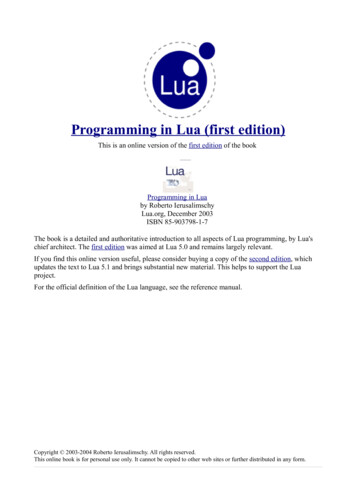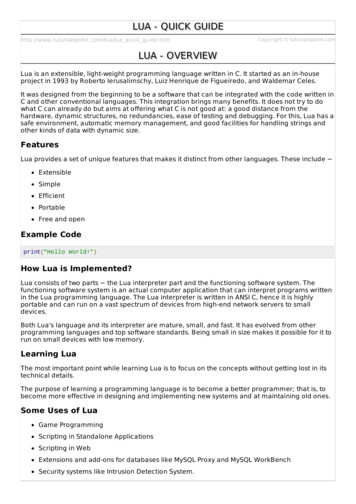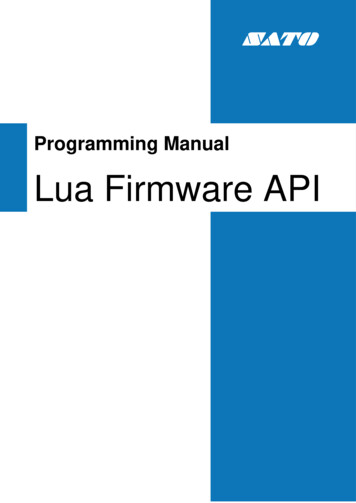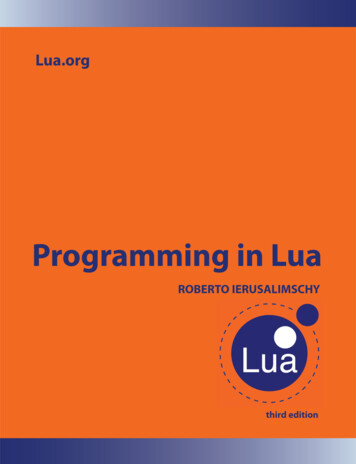
Transcription
Programming in Lua (first edition)This is an online version of the first edition of the bookProgramming in Luaby Roberto IerusalimschyLua.org, December 2003ISBN 85-903798-1-7The book is a detailed and authoritative introduction to all aspects of Lua programming, by Lua'schief architect. The first edition was aimed at Lua 5.0 and remains largely relevant.If you find this online version useful, please consider buying a copy of the second edition, whichupdates the text to Lua 5.1 and brings substantial new material. This helps to support the Luaproject.For the official definition of the Lua language, see the reference manual.Copyright 2003-2004 Roberto Ierusalimschy. All rights reserved.This online book is for personal use only. It cannot be copied to other web sites or further distributed in any form.
ContentsPart I · The Language 1 - Getting Started 1.1 - Chunks 1.2 - Global Variables 1.3 - Some Lexical Conventions 1.4 - The Stand-Alone Interpreter 2 - Types and Values 2.1 - Nil 2.2 - Booleans 2.3 - Numbers 2.4 - Strings 2.5 - Tables 2.6 - Functions 2.7 - Userdata and Threads 3 - Expressions 3.1 - Arithmetic Operators 3.2 - Relational Operators 3.3 - Logical Operators 3.4 - Concatenation 3.5 - Precedence 3.6 - Table Constructors 4 - Statements 4.1 - Assignment 4.2 - Local Variables and Blocks 4.3 - Control Structures 4.3.1 - if then else 4.3.2 - while 4.3.3 - repeat 4.3.4 - Numeric for 4.3.5 - Generic for 4.4 - break and return 5 - Functions 5.1 - Multiple Results 5.2 - Variable Number of Arguments 5.3 - Named Arguments 6 - More about Functions 6.1 - Closures 6.2 - Non-Global Functions 6.3 - Proper Tail Calls 7 - Iterators and the Generic for 7.1 - Iterators and Closures 7.2 - The Semantics of the Generic for 7.3 - Stateless Iterators 7.4 - Iterators with Complex State
7.5 - True Iterators 8 - Compilation, Execution, and Errors 8.1 - The require Function 8.2 - C Packages 8.3 - Errors 8.4 - Error Handling and Exceptions 8.5 - Error Messages and Tracebacks 9 - Coroutines 9.1 - Coroutine Basics 9.2 - Pipes and Filters 9.3 - Coroutines as Iterators 9.4 - Non-Preemptive Multithreading 10 - Complete Examples 10.1 - Data Description 10.2 - Markov Chain Algorithm Part II · Tables and Objects 11 - Data Structures 11.1 - Arrays 11.2 - Matrices and Multi-Dimensional Arrays 11.3 - Linked Lists 11.4 - Queues and Double Queues 11.5 - Sets and Bags 11.6 - String Buffers 12 - Data Files and Persistence 12.1 - Serialization 12.1.1 - Saving Tables without Cycles 12.1.2 - Saving Tables with Cycles 13 - Metatables and Metamethods 13.1 - Arithmetic Metamethods 13.2 - Relational Metamethods 13.3 - Library-Defined Metamethods 13.4 - Table-Access Metamethods 13.4.1 - The index Metamethod 13.4.2 - The newindex Metamethod 13.4.3 - Tables with Default Values 13.4.4 - Tracking Table Accesses 13.4.5 - Read-Only Tables 14 - The Environment 14.1 - Accessing Global Variables with Dynamic Names 14.2 - Declaring Global Variables 14.3 - Non-Global Environments 15 - Packages 15.1 - The Basic Approach 15.2 - Privacy
15.3 - Packages and Files 15.4 - Using the Global Table 15.5 - Other Facilities 16 - Object-Oriented Programming 16.1 - Classes 16.2 - Inheritance 16.3 - Multiple Inheritance 16.4 - Privacy 16.5 - The Single-Method Approach 17 - Weak Tables 17.1 - Memoize Functions 17.2 - Object Attributes 17.3 - Revisiting Tables with Default Values Part III · The Standard Libraries 18 - The Mathematical Library 19 - The Table Library 19.1 - Array Size 19.2 - Insert and Remove 19.3 - Sort 20 - The String Library 20.1 - Pattern-Matching Functions 20.2 - Patterns 20.3 - Captures 20.4 - Tricks of the Trade 21 - The I/O Library 21.1 - The Simple I/O Model 21.2 - The Complete I/O Model 21.2.1 - A Small Performance Trick 21.2.2 - Binary Files 21.3 - Other Operations on Files 22 - The Operating System Library 22.1 - Date and Time 22.2 - Other System Calls 23 - The Debug Library 23.1 - Introspective Facilities 23.1.1 - Accessing Local Variables 23.1.2 - Accessing Upvalues 23.2 - Hooks 23.3 - Profiles Part IV · The C API 24 - An Overview of the C API 24.1 - A First Example 24.2 - The Stack
24.2.1 - Pushing Elements 24.2.2 - Querying Elements 24.2.3 - Other Stack Operations 24.3 - Error Handling with the C API 24.3.1 - Error Handling in Application Code 24.3.2 - Error Handling in Library Code 25 - Extending your Application 25.1 - Table Manipulation 25.2 - Calling Lua Functions 25.3 - A Generic Call Function 26 - Calling C from Lua 26.1 - C Functions 26.2 - C Libraries 27 - Techniques for Writing C Functions 27.1 - Array Manipulation 27.2 - String Manipulation 27.3 - Storing State in C Functions 27.3.1 - The Registry 27.3.2 - References 27.3.3 - Upvalues 28 - User-Defined Types in C 28.1 - Userdata 28.2 - Metatables 28.3 - Object-Oriented Access 28.4 - Array Access 28.5 - Light Userdata 29 - Managing Resources 29.1 - A Directory Iterator 29.2 - An XML Parser1 - Getting StartedTo keep with the tradition, our first program in Lua just prints "Hello World":print("Hello World")If you are using the stand-alone Lua interpreter, all you have to do to run your first program is tocall the interpreter (usually named lua) with the name of the text file that contains your program.For instance, if you write the above program in a file hello.lua, the following command shouldrun it:prompt lua hello.luaAs a slightly more complex example, the following program defines a function to compute thefactorial of a given number, asks the user for a number, and prints its factorial:-- defines a factorial functionfunction fact (n)if n 0 thenreturn 1
elsereturn n * fact(n-1)endendprint("enter a number:")a io.read("*number")print(fact(a))-- read a numberIf you are using Lua embedded in an application, such as CGILua or IUPLua, you may need to referto the application manual (or to a "local guru") to learn how to run your programs. Nevertheless,Lua is still the same language; most things that we will see here are valid regardless of how you areusing Lua. For a start, we recommend that you use the stand-alone interpreter (that is, the luaexecutable) to run your first examples and experiments.1 - Getting StartedTo keep with the tradition, our first program in Lua just prints "Hello World":print("Hello World")If you are using the stand-alone Lua interpreter, all you have to do to run your first program is tocall the interpreter (usually named lua) with the name of the text file that contains your program.For instance, if you write the above program in a file hello.lua, the following command shouldrun it:prompt lua hello.luaAs a slightly more complex example, the following program defines a function to compute thefactorial of a given number, asks the user for a number, and prints its factorial:-- defines a factorial functionfunction fact (n)if n 0 thenreturn 1elsereturn n * fact(n-1)endendprint("enter a number:")a io.read("*number")print(fact(a))-- read a numberIf you are using Lua embedded in an application, such as CGILua or IUPLua, you may need to referto the application manual (or to a "local guru") to learn how to run your programs. Nevertheless,Lua is still the same language; most things that we will see here are valid regardless of how you areusing Lua. For a start, we recommend that you use the stand-alone interpreter (that is, the luaexecutable) to run your first examples and experiments.1.1 - ChunksEach piece of code that Lua executes, such as a file or a single line in interactive mode, is a chunk.More specifically, a chunk is simply a sequence of statements.
A semicolon may optionally follow any statement. Usually, I use semicolons only to separate two ormore statements written in the same line, but this is just a convention. Line breaks play no role inLua's syntax; for instance, the following four chunks are all valid and equivalent:a 1b a*2a 1;b a*2;a 1 ; b a*2a 1b a*2-- ugly, but validA chunk may be as simple as a single statement, such as in the "hello world" example, or it may becomposed of a mix of statements and function definitions (which are assignments actually, as wewill see later), such as the factorial example. A chunk may be as large as you wish. Because Lua isused also as a data-description language, chunks with several megabytes are not uncommon. TheLua interpreter has no problems at all with large sizes.Instead of writing your program to a file, you may run the stand-alone interpreter in interactivemode. If you call Lua without any arguments, you will get its prompt:Lua 5.0 Copyright (C) 1994-2003 Tecgraf, PUC-RioThereafter, each command that you type (such as print "Hello World") executesimmediately after you press enter . To exit the interactive mode and the interpreter, just typeend-of-file (ctrl-D in Unix, ctrl-Z in DOS/Windows), or call the exit function, from theOperating System library (you have to type os.exit() enter ).In interactive mode, Lua usually interprets each line that you type as a complete chunk. However, ifit detects that the line cannot form a complete chunk, it waits for more input, until it has a completechunk. When Lua is waiting for a line continuation, it shows a different prompt (typically ).Therefore, you can enter a multi-line definition, such as the factorial function, directly ininteractive mode. Sometimes, however, it is more convenient to put such definitions in a file, andthen call Lua to run that file.You can execute a sequence of chunks by giving them all as arguments to the stand-aloneinterpreter, with the -l option. For instance, if you have a file a with a single statement x 1 andanother file b with the statement print(x), the command lineprompt lua -la -lbwill run the chunk in a, then the one in b, which will print the expected 1. (The -l option actuallycalls require, which looks for the files in a specific path. So, the previous example will not workif this path does not include the current directory. We will discuss the require function in moredetails in Section 8.1.)You may use the -i option to instruct Lua to start an interactive session after running the givenchunks. A command line likeprompt lua -i -la -lbwill run the chunk in a, then the one in b, and then prompt you for interaction. This is especiallyuseful for debugging and manual testing. At the end of this chapter we will see other options for thestand-alone interpreter.Another way to link chunks is with the dofile function, which immediately executes a file. For
instance, you may have a file lib1.lua:-- file 'lib1.lua'function norm (x, y)local n2 x 2 y 2return math.sqrt(n2)endfunction twice (x)return 2*xendThen, in interactive mode, you can type dofile("lib1.lua") n norm(3.4, 1.0) print(twice(n))-- load your library-- 7.0880180586677The dofile function is useful also when you are testing a piece of code. You can work with twowindows: One of them is a text editor with your program (in a file prog.lua, say) and the other isa console running Lua in interactive mode. After saving a modification that you make to yourprogram, you execute dofile("prog.lua") in the Lua console to load the new code; then youcan exercise the new code, calling its functions and printing the results.1.2 - Global VariablesGlobal variables do not need declarations. You simply assign a value to a global variable to create it.It is not an error to access a non-initialized variable; you just get the special value nil as the result:print(b)b 10print(b)-- nil-- 10Usually you do not need to delete global variables; if your variable is going to have a short life, youshould use a local variable. But, if you need to delete a global variable, just assign nil to it:b nilprint(b)-- nilAfter that, it is as if the variable had never been used. In other words, a global variable is existent if(and only if) it has a non-nil value.1.3 - Some Lexical ConventionsIdentifiers in Lua can be any string of letters, digits, and underscores, not beginning with a digit; forinstanceiji10aSomewhatLongNameijINPUTYou should avoid identifiers starting with an underscore followed by one or more uppercase letters(e.g., VERSION); they are reserved for special uses in Lua. Usually, I reserve the identifier (asingle underscore) for a dummy variable.In Lua, the concept of what is a letter is locale dependent. Therefore, with a proper locale, you canuse variable names such as índice or ação. However, such names will make your program
unsuitable to run in systems that do not support that locale.The following words are reserved; we cannot use them as a is case-sensitive: and is a reserved word, but And and AND are two other different identifiers.A comment starts anywhere with a double hyphen (--) and runs until the end of the line. Lua alsooffers block comments, which start with --[[ and run until the corresponding ]]. A commontrick, when we want to comment out a piece of code, is to write the following:--[[print(10)--]]-- no action (comment)Now, if we add a single hyphen to the first line, the code is in again:---[[print(10)--]]-- 10In the first example, the -- in the last line is still inside the block comment. In the second example,the sequence ---[[ does not start a block comment; so, the print is outside comments. In thiscase, the last line becomes an independent comment, as it starts with --.1.4 - The Stand-Alone InterpreterThe stand-alone interpreter (also called lua.c due to its source file, or simply lua due to itsexecutable) is a small program that allows the direct use of Lua. This section presents its mainoptions.When the interpreter loads a file, it ignores its first line if that line starts with a number sign ( # ).That feature allows the use of Lua as a script interpreter in Unix systems. If you start your programwith something like#!/usr/local/bin/lua(assuming that the stand-alone interpreter is located at /usr/local/bin), or#!/usr/bin/env luathen you can call the program directly, without explicitly calling the Lua interpreter.The usage of lua islua [options] [script [args]]Everything is optional. As we have seen already, when we call lua without arguments theinterpreter enters in interactive mode.The -e option allows us to enter code directly into the command line. For instance,prompt lua -e "print(math.sin(12))"-- -0.53657291800043
(Unix needs the double quotes to stop the shell from interpreting the parentheses.) As we previouslysaw, -l loads a file and -i enters interactive mode after running the other arguments. So, forinstance, the callprompt lua -i -l a.lua -e "x 10"will load the file a.lua, then execute the assignment x 10, and finally present a prompt forinteraction.Whenever the global variable PROMPT is defined, lua uses its value as the prompt wheninteracting. So, you can change the prompt with a call like this:prompt lua -i -e " PROMPT ' lua '"lua We are assuming that "prompt" is the system's prompt. In the example, the outer quotes stop theshell from interpreting the inner quotes, which are interpreted by Lua. More exactly, Lua receivesthe following command to run:PROMPT ' lua 'which assigns the string " lua " to the global variable PROMPT.Before it starts running arguments, lua looks for an environment variable called LUA INIT. Ifthere is such a variable and its content is @filename, then lua loads the given file. If LUA INIT isdefined but does not start with @ , then lua assumes that it contains Lua code and runs it. Thisvariable gives you great power when configuring the stand-alone interpreter, because you have thefull power of Lua in the configuration. You can pre-load packages, change the prompt and the path,define your own functions, rename or delete functions, and so on.A main script can retrieve its arguments in the global variable arg. In a call likeprompt lua script a b clua creates the table arg with all the command-line arguments, before running the script. Thescript name goes into index 0; its first argument (a in the example), goes to index 1, and so on.Eventual options go to negative indices, as they appear before the script. For instance, in the callprompt lua -e "sin math.sin" script a blua collects the arguments as follows:arg[-3] "lua"arg[-2] "-e"arg[-1] "sin math.sin"arg[0] "script"arg[1] "a"arg[2] "b"More often than not, the script only uses the positive indices (arg[1] and arg[2], in theexample).2 - Types and ValuesLua is a dynamically typed language. There are no type definitions in the language; each valuecarries its own type.
There are eight basic types in Lua: nil, boolean, number, string, userdata, function, thread, andtable. The type function gives the type name of a given value:print(type("Hello (type(type(X)))-- -- -- -- -- -- -- stringnumberfunctionfunctionbooleannilstringThe last example will result in "string" no matter the value of X, because the result of type isalways a string.Variables have no predefined types; any variable may contain values of any type:print(type(a))a 10print(type(a))a "a string!!"print(type(a))a printa(type(a))-- nil( a' is not initialized)-- number-- string-- yes, this is valid!-- functionNotice the last two lines: Functions are first-class values in Lua; so, we can manipulate them likeany other value. (More about that in Chapter 6.)Usually, when you use a single variable for different types, the result is messy code. However,sometimes the judicious use of this facility is helpful, for instance in the use of nil to differentiate anormal return value from an exceptional condition.2.1 - NilNil is a type with a single value, nil, whose main property is to be different from any other value.As we have seen, a global variable has a nil value by default, before a first assignment, and you canassign nil to a global variable to delete it. Lua uses nil as a kind of non-value, to represent theabsence of a useful value.2.2 - BooleansThe boolean type has two values, false and true, which represent the traditional boolean values.However, they do not hold a monopoly of condition values: In Lua, any value may represent acondition. Conditionals (such as the ones in control structures) consider false and nil as false andanything else as true. Beware that, unlike some other scripting languages, Lua considers both zeroand the empty string as true in conditional tests.2.3 - NumbersThe number type represents real (double-precision floating-point) numbers. Lua has no integer type,as it does not need it. There is a widespread misconception about floating-point arithmetic errorsand some people fear that even a simple increment can go weird with floating-point numbers. Thefact is that, when you use a double to represent an integer, there is no rounding error at all (unless
the number is greater than 100,000,000,000,000). Specifically, a Lua number can represent any longinteger without rounding problems. Moreover, most modern CPUs do floating-point arithmetic asfast as (or even faster than) integer arithmetic.It is easy to compile Lua so that it uses another type for numbers, such as longs or single-precisionfloats. This is particularly useful for platforms without hardware support for floating point. See thedistribution for detailed instructions.We can write numeric constants with an optional decimal part, plus an optional decimal exponent.Examples of valid numeric constants are:40.44.57e-30.3e125e 202.4 - StringsStrings have the usual meaning: a sequence of characters. Lua is eight-bit clean and so strings maycontain characters with any numeric value, including embedded zeros. That means that you canstore any binary data into a string. Strings in Lua are immutable values. You cannot change acharacter inside a string, as you may in C; instead, you create a new string with the desiredmodifications, as in the next example:a "one string"b string.gsub(a, "one", "another")print(a)-- one stringprint(b)-- another string-- change string partsStrings in Lua are subject to automatic memory management, like all Lua objects. That means thatyou do not have to worry about allocation and deallocation of strings; Lua handles this for you. Astring may contain a single letter or an entire book. Lua handles long strings quite efficiently.Programs that manipulate strings with 100K or 1M characters are not unusual in Lua.We can delimit literal strings by matching single or double quotes:a "a line"b 'another line'As a matter of style, you should use always the same kind of quotes (single or double) in a program,unless the string itself has quotes; then you use the other quote, or escape those quotes withbackslashes. Strings in Lua can contain the following C-like escape sequences:\a bell\b back space\f form feed\n newline\r carriage return\t horizontal tab\v vertical tab\\ backslash\" double quote\' single quote\[ left square bracket\] right square bracketWe illustrate their use in the following examples:
print("one line\nnext line\n\"in quotes\", 'in quotes'")one linenext line"in quotes", 'in quotes' print('a backslash inside quotes: \'\\\'')a backslash inside quotes: '\' print("a simpler way: '\\'")a simpler way: '\'We can specify a character in a string also by its numeric value through the escape sequence \ddd,where ddd is a sequence of up to three decimal digits. As a somewhat complex example, the twoliterals "alo\n123\"" and '\97lo\10\04923"' have the same value, in a system usingASCII: 97 is the ASCII code for a, 10 is the code for newline, and 49 (\049 in the example) is thecode for the digit 1.We can delimit literal strings also by matching double square brackets [[.]]. Literals in thisbracketed form may run for several lines, may nest, and do not interpret escape sequences.Moreover, this form ignores the first character of the string when this character is a newline. Thisform is especially convenient for writing strings that contain program pieces; for instance,page [[ HTML HEAD TITLE An HTML Page /TITLE /HEAD BODY A HREF "http://www.lua.org" Lua /A [[a text between double brackets]] /BODY /HTML ]]write(page)Lua provides automatic conversions between numbers and strings at run time. Any numericoperation applied to a string tries to convert the string to a number:print("10" 1)print("10 1")print("-5.3e-10"*"2")print("hello" 1)-- 11-- 10 1-- -1.06e-09-- ERROR (cannot convert "hello")Lua applies such coercions not only in arithmetic operators, but also in other places that expect anumber. Conversely, whenever it finds a number where it expects a string, Lua converts the numberto a string:print(10 . 20)-- 1020(The . is the string concatenation operator in Lua. When you write it right after a numeral, youmust separate them with a space; otherwise, Lua thinks that the first dot is a decimal point.)Despite those automatic conversions, strings and numbers are different things. A comparison like10 "10" is always false, because 10 is a number and "10" is a string. If you need to converta string to a number explicitly, you can use the function tonumber, which returns nil if the stringdoes not denote a proper number:line io.read()-- read a linen tonumber(line)-- try to convert it to a numberif n nil thenerror(line . " is not a valid number")
elseprint(n*2)endTo convert a number to a string, you can call the function tostring or concatenate the numberwith the empty string:print(tostring(10) "10")print(10 . "" "10")-- true-- trueSuch conversions are always valid.2.5 - TablesThe table type implements associative arrays. An associative array is an array that can be indexednot only with numbers, but also with strings or any other value of the language, except nil.Moreover, tables have no fixed size; you can add as many elements as you want to a tabledynamically. Tables are the main (in fact, the only) data structuring mechanism in Lua, and apowerful one. We use tables to represent ordinary arrays, symbol tables, sets, records, queues, andother data structures, in a simple, uniform, and efficient way. Lua uses tables to represent packagesas well. When we write io.read, we mean "the read entry from the io package". For Lua, thatmeans "index the table io using the string "read" as the key".Tables in Lua are neither values nor variables; they are objects. If you are familiar with arrays inJava or Scheme, then you have a fair idea of what we mean. However, if your idea of an arraycomes from C or Pascal, you have to open your mind a bit. You may think of a table as adynamically allocated object; your program only manipulates references (or pointers) to them.There are no hidden copies or creation of new tables behind the scenes. Moreover, you do not haveto declare a table in Lua; in fact, there is no way to declare one. You create tables by means of aconstructor expression, which in its simplest form is written as {}:a {}-- create a table and store its reference in a'k "x"a[k] 10-- new entry, with key "x" and value 10a[20] "great" -- new entry, with key 20 and value "great"print(a["x"])-- 10k 20print(a[k])-- "great"a["x"] a["x"] 1-- increments entry "x"print(a["x"])-- 11A table is always anonymous. There is no fixed relationship between a variable that holds a tableand the table itself:a {}a["x"] 10b a-- b' refers to the same table as a'print(b["x"]) -- 10b["x"] 20print(a["x"]) -- 20a nil-- now only b' still refers to the tableb nil-- now there are no references left to the tableWhen a program has no references to a table left, Lua memory management will eventually deletethe table and reuse its memory.Each table may store values with different types of indices and it grows as it needs to accommodate
new entries:a {}-- empty table-- create 1000 new entriesfor i 1,1000 do a[i] i*2 endprint(a[9])-- 18a["x"] 10print(a["x"]) -- 10print(a["y"]) -- nilNotice the last line: Like global variables, table fields evaluate to nil if they are not initialized. Alsolike global variables, you can assign nil to a table field to delete it. That is not a coincidence: Luastores global variables in ordinary tables. More about this subject in Chapter 14.To represent records, you use the field name as an index. Lua supports this representation byproviding a.name as syntactic sugar for a["name"]. So, we could write the last lines of theprevious example in a cleanlier manner asa.x 10print(a.x)print(a.y)-- same as a["x"] 10-- same as print(a["x"])-- same as print(a["y"])For Lua, the two forms are equivalent and can be intermixed freely; but for a human reader, eachform may signal a different intention.A common mistake for beginners is to confuse a.x with a[x]. The first form represents a["x"],that is, a table indexed by the string "x". The second form is a table indexed by the value of thevariable x. See the difference:a {}x "y"a[x] 10print(a[x])print(a.x)print(a.y)------- 10-- nil-- 10put 10 in field "y"value of field "y"value of field "x" (undefined)value of field "y"To represent a conventional array, you simply use a table with integer keys. There is no way todeclare its size; you just initialize the elements you need:-- read 10 lines storing them in a tablea {}for i 1,10 doa[i] io.read()endWhen you iterate over the elements of the array, the first non-initialized index will result in nil; youcan use this value as a sentinel to represent the end of the array. For instance, you could print thelines read in the last example with the following code:-- print the linesfor i,line in ipairs(a) doprint(line)endThe basic Lua library provides ipairs, a handy function that allows you to iterate over theelements of an array, following the convention that the array ends at its first nil element.Since you can index a table with any value, you can start the indices of an array with any numberthat pleases you. However, it is customary in Lua to start arrays with one (and not with zero, as inC) and the standard libraries stick to this convention.
Because we can index a table with any type, when indexing a table we have the same subtleties thatarise in equality. Although we can index a table both with the number 0 and with the string "0",these two values are different (according to equality) and therefore denote different positions in atable. By the same token, the strings " 1", "01", and "1" all denote different positions. When indoubt about the actual types of your indices, use an explicit conversion to be sure:i 10; j "10"; k " 10"a {}a[i] "one value"a[j] "another value"a[k] "yet another value"print(a[j])-- another valueprint(a[k])-- yet another valueprint(a[tonumber(j)]) -- one valueprint(a[tonumber(k)]) -- one valueYou can introduce subtle bugs in your program if you do not pay attention to this point.2.6 - FunctionsFunctions are first-class values in Lua. That means that functions can be stored in variables, passedas arguments to other functions, and returned as results. Such facilities give great flexibility to thelanguage: A program may redefine a function to add new functionality, or simply erase a function tocreate a secure environment when running a piece of untrusted code (such as code received througha network). Moreover, Lua offers good support for functional programming, including nestedfunctions with proper lexical scoping; just wait. Finally, first-class functions play a key role in Lua'sobject-oriented facilities, as we will see in Chapter 16.Lua can call functions written in Lua and functions written in C. All the standard library in Lua iswritten in C. It comprises functions for string manipulation, table manipulation, I/O, access to basicoperating system facilities, mathematical fu
Programming in Lua by Roberto Ierusalimschy Lua.org, December 2003 ISBN 85-903798-1-7 The book is a detailed and authoritative introduction to all aspects of Lua programming, by Lua's chief architect. The first edition was aimed at Lua 5.0 and remains largely relevant.










